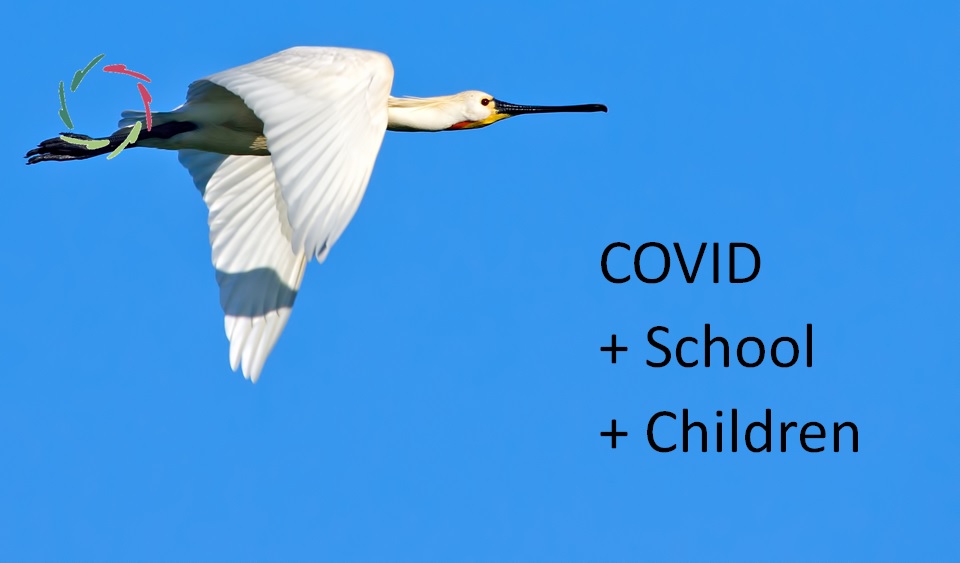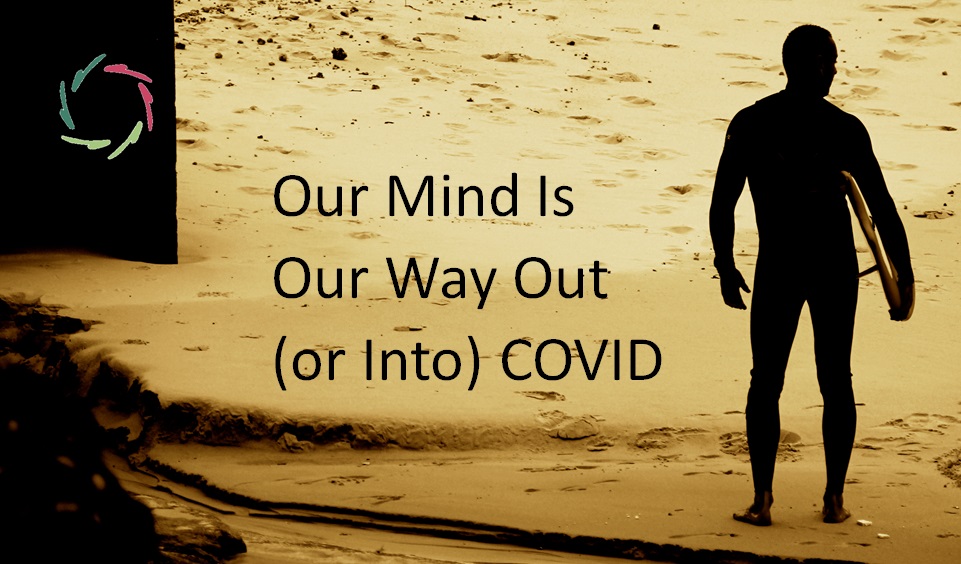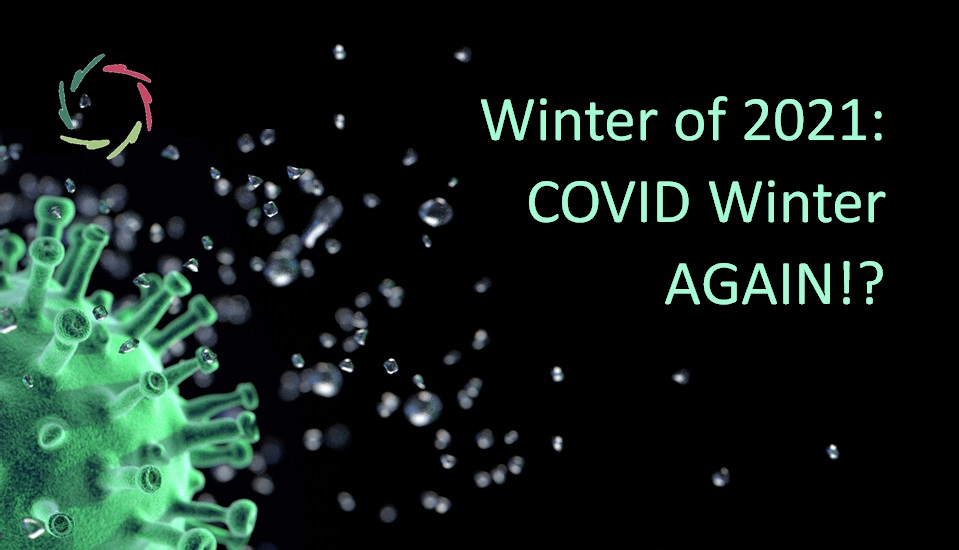24. COVID + School + Children

I’m fed up with corona. I want to be busy with Artificial Intelligence, with Lisa and my own well-being. Moreover, I do this for the sake of those who bite me. Then I look at the numbers and keep coroning. There’s much behind the numbers.
►►► WHY read this? Keeping schools open will be impossible. Not doing so, also. We need drastically creative solutions. ◄◄◄
Corona, just a kind of flu?
In a way, and even after all that has happened and before all that will happen still, it is probably correct. Look at South-East Asia. Even in the democratic West, if conceptually and subconceptually, we would have done the right things from the start on, or even from now on, the virus wouldn’t dictate us as it does, by far. Would the misery be little, as in flu-like? Nobody knows. But I dare say: probably. Even from now on, the pain (the deaths, the wounded, the financially devastated) would diminish drastically.
A few years from now, A.I.-driven real-world evidence may show whether or not this is correct.
Schools will reopen in Europe and the US.
At least a large number of them. Way too many and too open. After weeks, the situation will be unbearable. Will this be mainly school-driven? Nobody will ‘know for sure.’
Yet this will cause a surplus of many deaths and other mishaps, for sure.
Due to pressure, schools should again be partially closed.
So far, so obvious. That’s why I don’t question it. I assert it.
Did ‘the virus’ surprise you? It negatively surprised me several times already. Time and again, I see mayhem coming, but I’m surprised by how quickly. Of course, if you reckon with a COVID-whirlpool, you don’t know how strong the current is if you’re not inside.
So, I give the school re-closing ample time. Six to eight weeks? I may be wrong again. I would so much like to be wrong positively!
Of course, everybody wants to do good for the children.
And their parents. And the economy for which the parents need to work instead of educating their children.
And the economists who see that we financially don’t survive the second lockdown in the way of the first one. We’re still unsure whether we’ll financially survive the first one. Many individuals and small companies will not. Yet the general population is hardly aware of
second lockdown → probable meltdown → socio-economic-political whirlpool.
I am getting nervous
‘For the good of the children’ is not good for the children. Unfortunately, the children will suffer in any case. By rashly opening schools, all in all, they will suffer more, not less.
Apart from hard economics, I see short-sighted empathy – or call it sympathy in this respect [see: “Landscape of Empathy“] – as a human asset that doesn’t always serve us well. This kind of empathy/sympathy may make one think that “at least, my small-part-of-the-world will not fare worse than the adjacent parts.” That is probably correct. What one does on top of this is an ethical choice with everlasting consequences.
Of course, everybody wants to do good for ‘the children.’ And in the first stage, it will be good for ‘the children.’ One can also distribute an infinite number of cigarettes for free. In the first stage, it will be good for smokers. But?
But?
> Only a small amount of children got positive tests in the spring.
>< The kids didn’t go to school, nor their teachers. It was spring, not the runny-nose season of autumn, nor the full corona-season of winter. Teachers had time and energy to be extremely cautious. ‘Motivation fatigue’ is not so much scientific as it is real. Also, kids may have negative tests while being infectious.
> Contact tracing didn’t point much to children during the last few months.
>< Children may be test-negative yet infect each other, such as by sticking mutual objects in their mouths, by frequently hugging each other, by not taking care in which direction they cough. -> It’s tough to contact-trace. With many people infected, there are always others who seem suspect besides the children. Also, children might infect adults while not getting sick. Then the adult may get ill and spread more virus to the child who then tests positive. This can be seen as an adult → child infection while it is the reverse.
OK. Don’t put too much effort in right-or-wrong of this. The spring is not the autumn. My point is that nothing is straightforward. We need to live with uncertainties, following science as well as we can.
Science (at least some, by now) about children and schools
I did my homework. A few top-notch scientific studies are revealing.
Ludvigsson, in a systematic review, points out that “Children are unlikely to be the main drivers of the pandemic. Opening up schools and kindergartens is unlikely to impact COVID-19 mortality rates in older people.” [Ludvigsson, 2020] Unfortunately, this study doesn’t distinguish between the ages of children. It appears to be concerning the little ones. Also, many of the studies in the review are small and seem flawed. Still, it’s a worthwhile study in general terms.
A German study finds viral loads to be less, but still quite substantial in symptomatic children versus symptomatic adults. Small symptomatic children (0-10 years) have less viral loads than the 11-20 years group. [Jones et al., 2020]
An excellent study from South Korea, yet to be published (but already accepted) identified 5,706 people who were the first to report Covid-19 symptoms in their households between January 20 and March 27, when schools were closed, tracing the 59,073 contacts of these “index cases.” This study shows that older infected children (10-19 years) spread SARS-CoV-2 as much, if not more than adults, while younger children do so much less although still substantially: around half that of all other ages together. [Park et al., 2020] I find ‘half’ very much! A limitation of the study, acknowledged by the researchers: the first person in a household to develop symptoms is not necessarily the first to have been infected. This way, the study may have underestimated the number of children who set off the chain of transmission within their households. The study also doesn’t show how efficiently non-symptomatic children spread the virus.
An article in Science about Chinese experiences concludes that (with highlight by me) “Although proactive school closures cannot interrupt transmission on their own, they can reduce peak incidence by 40 to 60% and delay the epidemic.” [Zhang et al., 2020] This and other research in Argentina, Italy and South-Korea [Neidhofer et al., 2020] shows that school-closure needs to be done early and drastically in order to have this optimum effect.
On July 30, a Lancet article concludes, very sensibly (with highlight by me): “To prevent a second COVID-19 wave, relaxation of physical distancing, including reopening of schools, in the UK must be accompanied by large-scale, population-wide testing of symptomatic individuals and effective tracing of their contacts, followed by isolation of diagnosed individuals.” [Panovska-Griffiths et al., 2020] Otherwise, and together with reopening of society, they warn of “a resulting second wave of infections 2.0 – 2.3 times the size of the original COVID-19 wave.” They also see a second wave peak in December versus February. As I understand this, it’s twice as long, twice as hard. That makes four. It’s just numbers, but in my view, with COVID-whirlpool-turbo on top, this is not an underestimate. Let us be extraordinarily cautious and SLOW.
My take on this: small children are, fortunately, no killer-bombs. COVID-adolescents are as infective as adults. But they get COVID-ill in smaller (although apparently mounting in time, already) numbers. On the other hand, they may get common colds in higher numbers, spreading SARS-CoV-2 virus this way. Also, one should look at direct contacts and at second-degree contacts and so on. Top-notch contact tracing is indeed a must. Without it, opening schools is a behind-the-screen cause of many deaths. Without it, one cannot choose for the former without the latter.
An non-exhaustive enumeration of what may go wrong.
[Note the COVID-whirlpool [see: “COVID-Whirlpool“] in every following point, without mentioning it.]
- When a teenager has the size of an adult, he is equally infective. He is, pragmatically seen, even more infective than an adult. He is an unknown spreader for a substantial amount of days. Also teenagers may have ‘unhygienic habits.’ No guilt to them, of course. It’s just what it is. This condition is related to uneven brain development (amygdalae versus prefrontal cortex, up to 23 years of age). [https://www.aacap.org/AACAP/Families_and_Youth/Facts_for_Families/FFF-Guide/The-Teen-Brain-Behavior-Problem-Solving-and-Decision-Making-095.aspx]
- School teachers are going to get sick. Some will die. Others will quit. Replacements will not be easy to find.
- Also, partners will get COVID, or be anxious to get it. They may not want to cohabit with their possible death sentence.
- Healthcare workers get school-COVID patients, of whom they know that the risks have been taken with more or less conscious intent. This will be emotionally extra hard.
- Teachers and students will be seen as guilty of school-borne infections, not taking precautions well enough. A number of them will indeed do so and be found guilty by others.
- Parents’ parents will die. Increasingly, it will become apparent, also through tracing, that a substantial source is school-bound. By then, too late for many. Lifelong, children-of-now will know they ’caused’ their grandparents dying.
- After a while, parents will make this deduction by themselves, and it will be in social and other media.
- Symptoms from a common cold, flu will get much attention, provoking much anxiety.
- The sensitivity and specificity of COVID tests will show its (low-level) worth in these specific circumstances of high prevalence and vague symptoms. This adds to people’s losing confidence in experts and expertise, making non-science flourish.
- We are giving the virus ample resources to learn to adapt to children -> detrimental mutations in the make. This is already going on. It’s a logical move by the virus, seeking broader habitats in the same way as it founds humans in 2019. It cannot help it. That’s what a virus does. However, this particular virus is more dangerous in this respect than most others.
- What with the safety of mentally disabled children and their teachers?
Back to the whirlpool. I don’t see this being taken into account anywhere. The situation with versus without whirlpool is comparable to a linear versus logarithmic progression. Or, if you like, something like a summation versus a multiplication in which, additionally, the terms themselves get bigger.
In a schema, with t for time and d for disaster:

Bye, bye, control. I wish you were here.
“But we didn’t see this coming!”
“Then, you didn’t read MINDING CORONA!” On top of that, you didn’t read the scientific literature very well. Dear reader, this makes me immensely sad. Please don’t throw any guilt to anyone. It’s not worth it, and it’s counterproductive.
But do let us be sad together.
We’re entitled to be so.
I wonder whether politicians are betting on a timely miracle cure (will not happen) and are willing to ram through a huge surplus number of deaths and wounded (complications) to ‘save the economy.’ Is the plan, for the sake of money, to accept a second wave four times as hard as the first one? Dearest reader, would it be acceptable to you? If in any country or part of the world, politicians have this plan, then I can tell them: You don’t know what you are meddling with. You see one part of the picture, and it may well be the smallest part. Your plan to ‘save the economy’ may thus backfire into even more economic ship-wrecking.
Some countries have successfully reopened schools, while others have closed them down again. The number of community cases to close down schools varies wildly from country to country. For instance, South-Korea, despite very good contact-tracing in place, closed down 840 schools based on some 80 new cases (not deaths) on one day. [https://www.businessinsider.nl/hundreds-south-korean-schools-closed-amid-spike-coronavirus-cases-2020-5?international=true&r=US] Belgium had 922 cases yesterday, with – everybody agrees – suboptimal contact-tracing in place.
Any alternative for schooling?
That is: apart from my theoretical and practical developments. The app! The app! My kingdom for the app! And it’s for free! And it’s apparently… for another planet.
I’m not a pedagogue, I don’t have any school-aged children. Nevertheless, since for the kids, after some time that will show to be more catastrophic than anything until now, school is impossible, and no-school is impossible, one needs to jump out of the box and into another box. Let’s try one. I call this ‘micro-schooling.’
Micro-schooling
The main idea is simple. Call me naïve if you like, but for some of you, my readers, the direction has crossed your mind already. Your further intelligence is needed to make an elephant into a mosquito.
It’s not applicable for all children, but for most, probably, at least with some additional insights in ‘deep motivation,’ etc. Also, this is not new. From country to country, already, aspects of this are being promoted or realized.
The basic idea: put four children together, let them be responsible for each other, to quite some degree. Every four to six weeks, groups may change. Let all group members be accountable individually and for each other within that group. Of course, they should have the means to communicate with each other. Computer? Coming together at school now and then: four children in one classroom, along with a teacher?
What’s in it for each?
- For the teacher, micro-school-bubbles are more workable than contacting every pupil individually.
- For the students, they learn invaluable lessons in co-creation, co-responsibility, co-motivation, even leadership.
- For the parents who are willing and able to do so: let the micro-schools (four children) be together during the day in one house, with one parent. Three others can go to work.
- For society: economy can hopefully keep going.
Just an idea. More important: the circumstance obliges us to be super-out-of-the-box-thinking.
That needs openness and respect.
And above all, it needs us to discover who we are and why it matters.
References
[Zhang et al., 2020] Zhang J, Litvinova M, Liang Y, et al. Changes in contact patterns shape the dynamics of the COVID-19 outbreak in China. Science. 2020;368(6498):1481-1486. doi:10.1126/science.abb8001
[Neidhofer et al., 2020] The Effectiveness of School Closures and Other Pre-Lockdown COVID-19 Mitigation Strategies in Argentina, Italy, and South Korea — Claudio Neidhofer, Guido Neidhofer – This version: July 3, 2020
[Ludvigsson, 2020] Ludvigsson JF. Children are unlikely to be the main drivers of the COVID-19 pandemic – A systematic review. Acta Paediatr. 2020;109(8):1525-1530. doi:10.1111/apa.15371
[Panovska-Griffiths et al., 2020] Panovska-Griffiths J, Kerr CC, Stuart RM, et al. Determining the optimal strategy for reopening schools, the impact of test and trace interventions, and the risk of occurrence of a second COVID-19 epidemic wave in the UK: a modelling study [published online ahead of print, 2020 Aug 3]. Lancet Child Adolesc Health. 2020;S2352-4642(20)30250-9. doi:10.1016/S2352-4642(20)30250-9
[Park et al., 2020] https://wwwnc.cdc.gov/eid/article/26/10/20-1315_article Park YJ, Choe YJ, Park O, et al. Contact Tracing during Coronavirus Disease Outbreak, South Korea, 2020 [published online ahead of print, 2020 Jul 16]. Emerg Infect Dis. 2020;26(10):10.3201/eid2610.201315. doi:10.3201/eid2610.201315
[Jones et al., 2020] Jones TC, Mühlemann B, Veith T, et al. An analysis of SARS-CoV-2 viral load by patient age (https://zoonosen.charite.de/fileadmin/user_upload/microsites/m_cc05/virologieccm/ dateien_upload/Weitere_Dateien/analysis-of-SARS-CoV-2-viral-load-by-patient-age.pdf). German Research network Zoonotic Infectious Diseases website: Charité – Universitätsmedizin Berlin, 2020.


